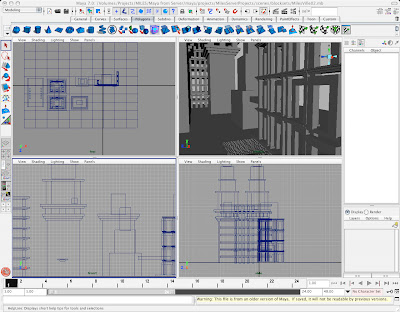Project 3: Continue creating your city shot by UV mapping and adding materials to your models.
In addition to the videos I've posted below,
Here is a really good short web tutorial intro to UV mapping in Maya.
Here is a zipped .pdf I put together on UV mapping a box in Maya.
DEMO VIDEOS
UV Mapping 101. This set of videos takes you through the fundamentals of UV mapping.
UV Mapping 102. This set of videos takes you through the steps of creating a custom building texture in Photoshop, setting up image planes as templates for your model, and editing an object's UVs to match the texture map in Maya.
REFLECTIVE ESSAY
Find three images with textures that appeal to you. Describe the textures and how they work. How do they contribute to the overall mood and feel of the image. If it's a 3D image, where do you think the textures came from?
Tuesday, January 18, 2011
Tuesday, January 11, 2011
Project 2: Sub-object modeling & UV mapping
Take one of your scenes and work on it using modeling, uv mapping, and lighting. Objects closest to the camera will probably need the most modeling. Try to take a modular approach to modeling where you can. A single pillar can be duplicated several times to create an arcade, or girders can be duplicated to create a bridge or building. UV mapping can be a good cheap way to create visual interest with shoddy models. Lighting can create visual interest and an illusion of depth. Lighting can help focus attention on built up areas of the shot and de-emphasize the undercooked zones. Post jpgs of your work in progress. Final render due Tuesday, January 18.
Sub-Object Modeling Videos
REFLECTIVE ESSAY
Pick 3 landscape/cityscape images and analyze how they create the illusion of scale and depth. Touch on the following
1. General composition
2. Foreground, mid-ground, background relationships.
3. Scale contrast
4. Use of value contrast (differences between light and dark)
5. Color (intensity, palette, warm/cool colors)
6. Placement of details
7. Do the images make use of a repoussoir (framing) device?
Sub-Object Modeling Videos
REFLECTIVE ESSAY
Pick 3 landscape/cityscape images and analyze how they create the illusion of scale and depth. Touch on the following
1. General composition
2. Foreground, mid-ground, background relationships.
3. Scale contrast
4. Use of value contrast (differences between light and dark)
5. Color (intensity, palette, warm/cool colors)
6. Placement of details
7. Do the images make use of a repoussoir (framing) device?
Tuesday, January 4, 2011
Project 1: Blockville
 PROJECT 1: BLOCKVILLE
PROJECT 1: BLOCKVILLERock out with your blocks out!
1. Find 10 images that use scale contrast and composition to help create a sense of size and distance. Post them to your blog with the title, "Project 1: Reference Material." Make sure you credit the artist for his/her work and provide a title, date, and a link back to the site that provided the work.
Fritz Lang's Metropolis (1927).
How's about some Piranesi? From the Carceri (Prisons) c. 1745-50.
These have been a big influence on just about everybody designing big, fantastical scenes with gigantic architectural scale.
BLOG
You are required to keep a blog for this course and post all of your lab projects there. If you're new to bloggin', I recommend blogger.com as it's free and easy to use. If you find a service that works better for you, however, by all means, go for it. Yes, you may use a blog you have started before this class, just make sure you label your posts clearly so I don't get cranky. Once you have your blog set up, post your name and your blog's URL as a comment to this post. You must do this today, January 4. Check the comments section of this post for an example of how to do this.
PHOTO
Take a photo of your self and post it in the "about me" section of your blog by Tuesday, January 11.
Each week, you'll have a reading or two and will write a reflective essay related to your project. You'll post your writing assignment to your blog along with your studio work. Your written reflection is 25% of your project grade and must be posted before class on Tuesday, January 11.
Here are your readings for the first week:
Reflective Essay Writing Tips For College Students
Interview with Joe Sanabria, Lead Artist, Fallout: New Vegas
Additional resources you may wish to consult:
cgsociety.org
conceptart.org
REFLECTIVE ESSAY:
Reflect on the process of doing your research and creating your scene. In two or three clear, precise paragraphs, try to answer at least three of the following questions: Did the interview give you any ideas on how to approach your project? Did you start with a plan and stick to it, or were there some unexpected discoveries along the way? Which do you think is your best final image? How did you decide a scene was 'finished'? Did you return to your work to edit it? Did you have some ideas of images you wanted to work with or did you just dive into the internet and start looking? Did you learn anything from this project that will become a part of your regular creative process? What kind of emotional responses were you trying to evoke in your imagery?
GRADING
I'll be using the following rubric to assess the project. 5 categories, maximum of 5 points per category. Click the image for a larger view or click here for the .docx file.
DEMO MATERIALS:
Here is a 10 minute video to get you started with Blockville!
How To Render:
Subscribe to:
Comments (Atom)


